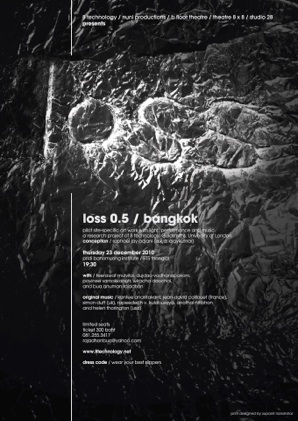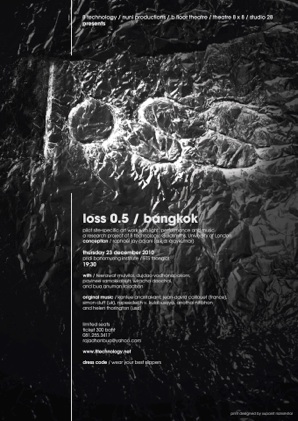8
technology -
towards a deep ecology of art, architecture and being
research project of goldsmiths, university of london
8
technology -
towards a deep ecology of art, architecture and being
research project of goldsmiths, university of london
director: raphael jay adjani
associate: sian ni mhuiri
loss 0.5 bangkok 2010
pilot presentation
หาย
และเจอ?
a site-specific art work u
in multiple media: architectural ,visual, music and performance arts
exploring loss, emptiness, chance, relationality and the sublime.
งานสื่อผสม
ทัศนศิลป์ ดนตรี และ การแสดง
เพื่อค้นหา การสูญเสีย ความว่างเปล่า ความเกี่ยวเนื่อง และ ความสูงส่งแห่งจิตวิญญาณ
concept engendered by:
raphael jay adjani
© 11.09.10
six commissioned original music compositions
four original choreographies
one original light work
one sublime d.j.
pridhi art institute
thong lo,
soy 1
5 minutes walk form thong lo bts station,
bangkok, thailand
23 december, 2010, 19.30
ticket price 300 baht
limited booking only: pattarasuda anuman rajadhon, tel. 081-255-3417
realised in collaboration with
choreographer-performers:
teerawat mulvilai grisana, pattarasuda anuman rajadhon, dujdao vadhanapakorn, wassadee wattanasuwan
composers:
kantee anantagant, jean-david caillouet, simon duff, rapeedech v. kulabusaya, anothai nitibhon, helen thorington
d.j.:
wiracha daochai
light artist
pavinee samakkabutr
photographer-graphic designer:
supanit riansrivilai
production assistants:
lookmod pukkakanant, punyisa laowanaboriboon
and any guests who wish to join on the night.
produced by
raphael jay adjani and pattarasuda anuman rajadhon
loss is an 8 technology research project of goldsmiths, university of london in partnership with
nuni productions,
and in association with
b floor, slow island, theatre 8x8, thammasat university.
หาย
และเจอ?
การแสดงที่สร้างสรรค์ขึ้นจากนักแสดง 4 คน นักประพันธ์ดนตรี 4 คน นักออกแบบแสง 1 คน และ ดีเจ 1 คน
ความยาว 64 นาที
แก่นของการแสดง
จินตนาการ ความว่างเปล่า แต่ขณะเดียวกันก็เต็มปรี่ และยังคงอยู่
ความมืด ที่มาพร้อมกับ แสงสว่าง
เสียง ที่ถูกสัมผัสด้วยความเงียบงัน
บางอย่างที่หายไป และการได้พบ เจอ กันอีกครา
การสูญเสียเป็นประสบการณ์สากล
มนุษย์ทุกคนได้เคยพบกับดวามเจ็บปวดที่มาพร้อมกับการสูญเสีย หรือการที่บางสิ่งบางคน หาย ไป
การสูญเสียผู้ที่เป็นที่รัก สามี ภรรยา พ่อ แม่ คนรัก ลูก เพื่อน
จินตนาการความหวังที่หายไปในชีวิต
จินตนาการการตะเกียกตะกากไขว่ขว้าที่จะเอาชนะช่องว่างเปล่านั้นเพื่อเติมเต็ม และเพื่อ เจอ กันอีกครั้ง
หาย ประกอบด้วยการแสดง 2 ส่วน
ส่วนที่ 1 ความยาว 48 นาที
นักแสดง 4 คน กับ เพลงที่ถูกแต่งขึ้นเพื่อการแสดงนี้โดยเฉพาะ 4 เพลง
เพลง 4 เพลง ถูกบันทึกลงไอพอด 4 เครื่อง
นักแสดงจับฉลากต่อหน้าคนดู
นักแสดง เล่าเรื่องราว การสูญเสีย ของตน กับดนตรีที่ ได้ฟังจากหูฟังเป็นครั้งแรก
ความสดที่เกิดขึ้นระหว่างนักแสดงกับเพลงใกล้เคียงกับ contact improvisation
คนดู ในห้วงแห่งความเงียบนั้น จินตนาการเสียงที่นักแสดงทั้ง 4 คนได้ยิน จากเรื่องที่พวกเขาเล่าออกมา
บนเวที มีดีเจ หนึ่งคน เขาเองก็จะได้ยินเพลงทั้ง 4 เพลงเป็นแรก พร้อมๆกัน
เขาเป็นคนเลือกว่าใน ขณะห้วงนั้นนั้น คนดูควรจะได้ยินเสียงอะไร
บทสนทนาได้เกิดขึ้นระหว่าง นักแสดง นักประพันธ์ ดนตรี คนดู และ ดีเจ
ส่วนที่ 2 ความยาว 16
คนดู แลกเปลี่ยนความคิด กับนักแสดง นักบระพันธ์และ ดีเจ
what is the theme?
loss is an inter-active and immersive experience in visual, musical and performance arts that explores loss, emptiness, chance, relationality, and the sublime.
visually, acoustically and emotionally: imagine emptiness as well as presence; darkness with light, sound touched by golden silence, loss and finding again.
loss is one of the universal experiences of pain and trauma that human beings invariably experience at least once in their lives. It could be the loss of a loved one such as a husband, wife, mother, father, lover, child, or friend. imagine loss of hope itself in life that we may sometimes feel; and the struggle to transcend loss: to find again.
loss is inspired by music associated with loss and melancholia - requiems, portuguese fado, Indian raags, joy division, as well as the original compositions of the participating composers.
imagine ritual and the engendering of sacred space.
loss is space-specific: the artists, working from an essential performance ‘template’ will change the presentation according to the mood of the audience and the nature of the space, the culture, the landscape.
imagine a particular spectatorship: an art of feeling, of affect. in classical south asian art aesthetics, including performance, works function to evoke and immerse you in particular aesthetic moods, tastes, and flavours (sanskrit: rasa) through suggestion (sanskrit: dhavani).
give me a picture?
part 01: (16 minutes):
Before she enters the auditorium, each spectator removes her shoes and socks, and her feet are washed by the artists. One artist cleans the floor of the stage. House lights go down and the stage is almost unlit.
part 02 (24 Minutes)
imagine four live artists and six composers and six original compositions made for this work. the music relates to each composer’s personal journey of loss.
each performance: four live artists perform their individual choreographies and stories of loss and attempt to re-find.
these choreographies are then shaped further renewed through the introduction of musical compositions of that the performers hear for the first time, through the nature of their interaction with each other as contact improvisation, and through their reaction to the moods of the audience they encounter each night.
the live artists wear headphones and an ipod, so each hears a different piece of music that the audience and fellow performers can only imagine, except at brief moments one of the compositions, fades up briefly during the performance. these moments will be chosen spontaneously by ‘d.j.’ wiracha daochai in response to what the artists perform and to the mood of the audience. here, like in south asian music and dance, there is a kind of conversation between the various components: performing artist, music, audience. each night the dancer pulls one of six ipods – each with one composition - out of a hat. s/he will not know which composition s/he will receive and must dance with.
individual solo performances would be developed from stories of loss. stories found and stories experienced by the artists who would be involved. the work would be developed through an improvisational process and personal interaction with the mood of the music. the significance of the personal is important here, as choreographer pina bausch stated, “I am not interested in how the dancer moves but what moves the dancer”.
here the project aim as at the creation of a character or an entity that is somewhere between human and object. objects that performers have found and inspire them that become attached to then and then evolve to become part of a new character that is somewhere between performance and the object. for this piece we are thinking about the space as a live entity. we wish to emphasise what we call 'relational being' and 'non-anthropocentric being'.
each live artist, wearing skin-tight luminous white costume moves through the space as if a phantom, a virtual image. s/he begins cleaning the stage floor and develops a unique performance, improvised each night. every so often a light artist, on stage always, using domestic lights only, lights a part of the space for a few seconds at times revealing the performer and then everything returns to near darkness. music is heard in this silence and momentarily provides an interval, a caesura to the silence. at the culmination a wall of lights at the back of the stage facing the audience come on very gradually, eventually ‘blinding’ the audience and then quickly go off.
part 03 (8 minutes):
house lights fade up slightly, music is played ‘continuously’ - chosen by d.j. - and any members of the audience who wish to may join the dance alongside the live artists - here it is total improvisation.
part 04 (16 minutes):
the house lights come fully on and the entire audience is invited to join the sharing where spectators and artists share their musings and experiences of the 48 minutes they have just witnessed. here they also have an opportunity to listen to the music played on the various ipods.
หาย

image by supanit riansrivilai


8 technology a.k.a. ecosophy 8 a.k.a. 8
brings together particular ideas from science, digital technology, philosophy, architecture and art to facilitate sublime works that shed light on our contemporary ecology and being.
this site is both ‘art ‘ and ‘information’ in that it can tell you about what 8 does, at the same time it is created and tended near daily, in a deliberate, ritualised process of re-construction and re-creation, according to mood, season, context,
-a durational work without duration -
a ‘technology’ of the every day,
in the manner of a daily tea ceremony or tending of a zen garden, for your pleasure...
each page is unique: constructed with minor compositional variation.
spot the deliberate imperfections.
view via the sublime filmic work, version for the internet: naka-ma
connect with 8 technology’s daily twitter
join the evolving discussion at facebook